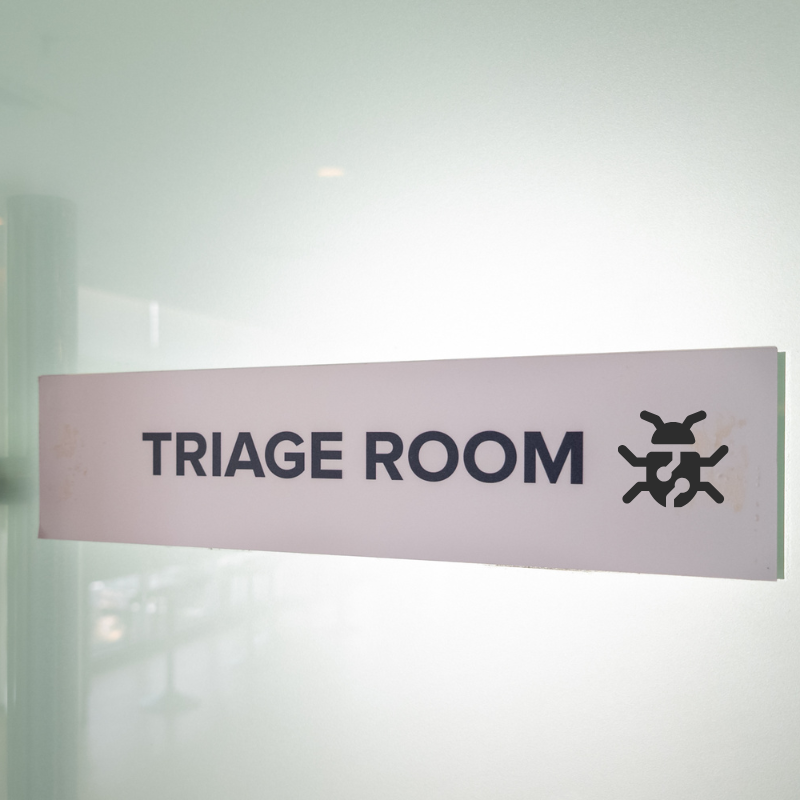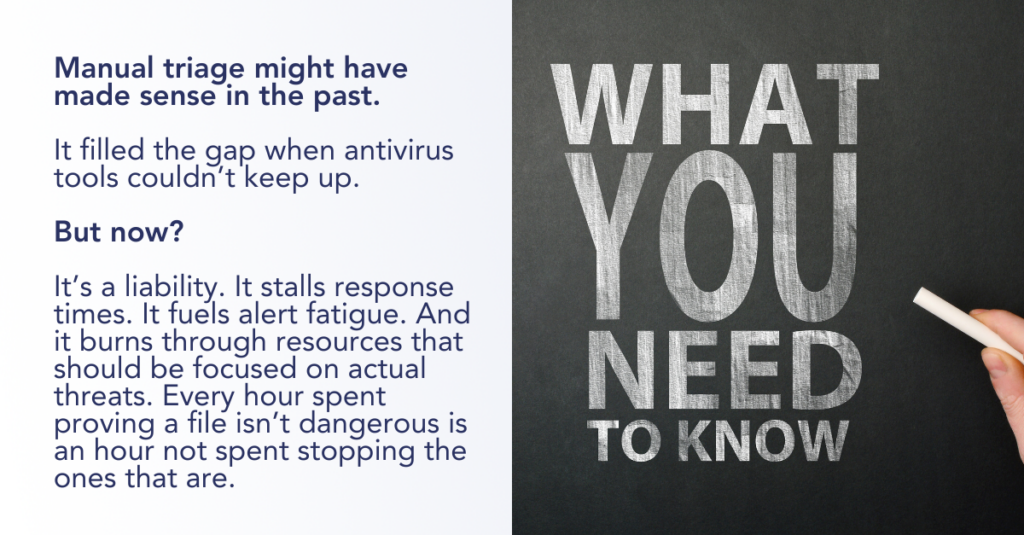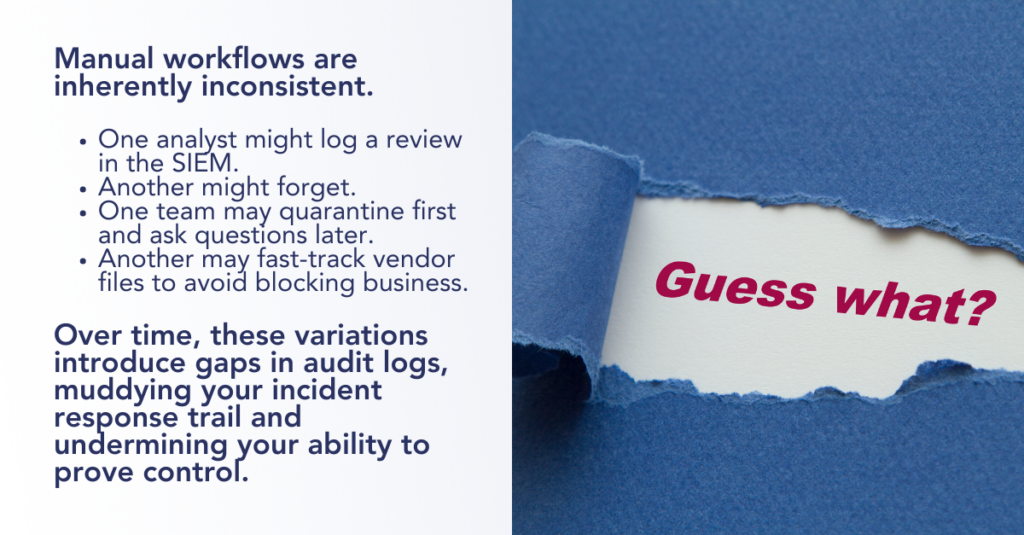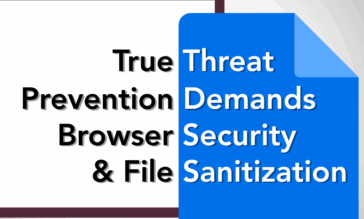Still Manually Triaging Files? It’s Time to Stop Playing the False Positive Game

Security teams aren’t just drowning in threats; they’re drowning in noise. Every day, SOC analysts waste hours digging through files flagged “just in case.” A PDF from a trusted vendor. A spreadsheet with macros that haven’t changed in years. A basic attachment that still sparks a ticket, a review, or an escalation. All that effort, all for a file that turns out to be totally clean.
Manual triage might have made sense in the past. It filled the gap when antivirus tools couldn’t keep up. But now? It’s a liability. It stalls response times. It fuels alert fatigue. And it burns through resources that should be focused on actual threats. Every hour spent proving a file isn’t dangerous is an hour not spent stopping the ones that are.
In an environment where speed matters and staffing is already stretched thin, clinging to manual file review isn’t due diligence, it’s a real drag. It’s time to cut the noise and rethink what file security should actually look like.

Manual Triage Wastes Time and Undermines Confidence
Every minute spent validating a harmless document is time stolen from a real investigation. And when that process becomes the norm, it creates ripple effects far beyond the SOC. Let’s take a closer look at how manual triage slows teams down and weakens the security posture it’s meant to support.
SOCs Are Buried in Benign Files
For every file-based threat that turns out to be real, dozens lead nowhere. Yet each one demands attention, triage, validation, and documentation. A harmless PDF triggers an alert. A macro-enabled spreadsheet raises a flag. An email attachment from a known vendor ends up in a review queue. And so the cycle begins: inspect, log, escalate, clear.
It’s death by a thousand false positives.
These aren’t malicious files; they’re just misunderstood by outdated tools that rely on signatures and guesses. But security teams can’t afford to assume.
We know what assuming does. And it isn’t just inefficient, it’s dangerous. Every moment spent reviewing a clean file is a moment not spent detecting lateral movement, responding to a breach, or tightening defenses elsewhere. It adds up to an overworked, under-focused, and constantly behind SOC. And all because the system doesn’t know how to tell what’s safe without asking someone to check.
Manual Review Weakens Compliance Posture
Beyond slowing down your security team, manual triage also creates blind spots in compliance. Every time a human analyst makes a judgment call whether a file is safe, risky, or somewhere in between, that decision must be recorded, justified, and repeatable. But in practice, that rarely happens cleanly.
Manual workflows are inherently inconsistent. One analyst might log a review in the SIEM. Another might forget. One team may quarantine first and ask questions later; another may fast-track vendor files to avoid blocking business. Over time, these variations introduce gaps in audit logs, muddying your incident response trail and undermining your ability to prove control.
It’s not just about doing the right thing for most compliance frameworks. It’s about showing how and when you did it. If file disposition isn’t automated and standardized, you’re left with scattered records, inconsistent enforcement, and policy exceptions that are hard to explain during an audit.

Efficiency Demands Invisible File Sanitization at Scale
The right technology can eliminate threats automatically, enforce consistency across every file interaction, and free your team to focus on what matters. The solution isn’t more reviews. It’s less risky. And that starts with making file sanitization seamless, scalable, and invisible.
Votiro Neutralizes the Threat Before You Even See It
Most file security tools rely on detection. Votiro doesn’t. Instead of waiting to identify something suspicious and flag it for review, Votiro assumes every file is a potential threat and sanitizes it before it ever reaches a user or endpoint. That’s zero trust cybersecurity at work.
Our Content Disarm and Reconstruction (CDR) technology breaks files down, removes malware, macros, embedded scripts, and exploit code, then rebuilds them using only safe, verified elements. The result is a clean, fully functional file that’s instantly safe to use, with no required sandboxing, quarantining, or manual triage.
Our advanced CDR eliminates the need for reactive security workflows. There are no exceptions to handle, no alerts to escalate, no decisions to make. Just safe, usable files delivered at speed—before your SOC even knows they were a risk.
Fewer Alerts = Faster Response
In a world of constant alerts, less truly is more. When every incoming file is sanitized before it hits the endpoint, the ripple effect is immediate: fewer alerts in your SIEM, fewer tickets in your queue, and fewer interruptions for your security team. That noise, the endless stream of harmless-but-flagged files, is silenced at the source.
Votiro eliminates the need for downstream triage. As a result, incident response teams can stay laser-focused on real threats, lateral movement, privilege abuse, and exfiltration without being pulled into a black hole of false positives and attachment reviews.
This shift doesn’t just improve efficiency, it extends capacity. Analysts aren’t spending their day logging benign events or second-guessing macros. They’re responding faster, thinking deeper, and burning out less. In short, you get better outcomes with less effort because the distractions never reach you in the first place.
Plus, Votiro’s benefits go beyond time savings. With built-in classification and consistent file handling, Votiro strengthens your compliance posture. Audit trails are clean. Documentation is automatic. And your team can finally spend time investigating what matters, not what’s already been neutralized.
Tired of investigating clean files? You should be. Let Votiro handle file threats before they reach your very human, very alert-fatigued security team. Book a demo today.
News you can use
Stay up-to-date on the latest industry news and get all the insights you need to navigate the cybersecurity world like a pro. It's as easy as using that form to the right. No catch. Just click, fill, subscribe, and sit back as the information comes to you.
Sign-up Here!
Subscribe to our newsletter for real-time insights about the cybersecurity industry.



